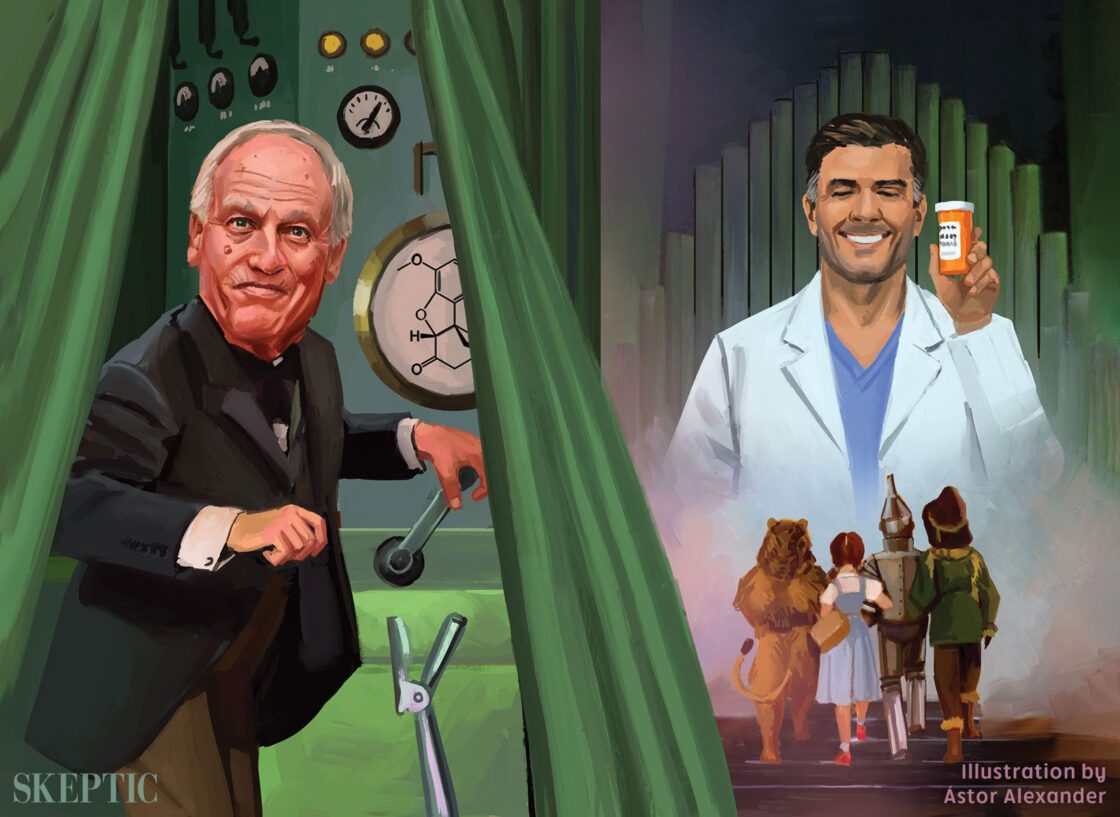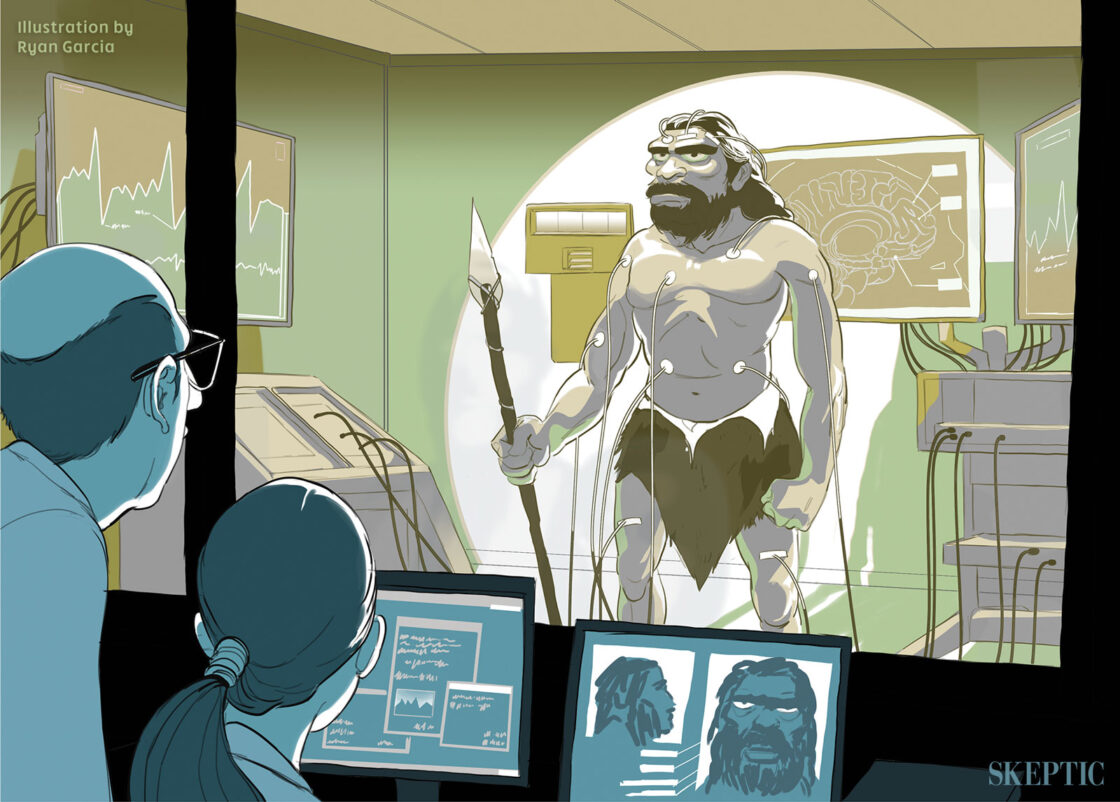For most people, radiation is very scary. You can’t see it; you may not know if you’ve been exposed. We’ve all read the horror stories about Hiroshima and Nagasaki. When radiation leaked from the Fukushima reactor in 2011, people all the way across the Pacific Ocean feared for their health. Alarmist headlines blared “Fukushima radiation has reached U.S. shores!” Cesium-134 had been measured in seawater samples from beaches in Oregon, and in Canadian salmon. A senior scientist quelled fears by putting this news into context: “if you were to swim every day for six hours a day in those waters for a year, that additional radiation from the addressed cesium from Japan…is 1000 times smaller than one dental x-ray.”1
Most people think radiation is not natural. Actually, yes it is. We are exposed to radiation from cosmic rays. We get more background radiation if we live in the mountains or fly frequently, and if we live in stone or brick houses or in homes with radon in the basement. There is radioactive potassium in bananas, potatoes, beer, and many other foods. Tobacco leaves contain radioactive polonium 210, with a half-life of 138 days. It falls onto the tobacco leaves from the atmosphere and is a major cause of lung cancer. We are even exposed to radiation from our own bodies. There is no way to avoid it. We know that ionizing radiation damages and mutates DNA and can cause cancer.
Many people are convinced that all radiation is potentially dangerous. The Health Physics Society has set safety levels, and workers’ doses are maintained at levels as low as reasonably achievable (ALARA); but they point out that “There is considerable uncertainty associated with the estimation of risk from relatively low doses.” This doesn’t mean there is no risk, but rather that there may not be any risk, and if there is, we don’t know how to quantify it. The problem is that the risk is so low that many millions of people would have to be studied to overcome the signal-to-noise ratio in the data, and the risk is confounded by varying background levels of radiation and other factors like radiation from diagnostic procedures. It’s an impossible problem that may never be definitively solved because of the sheer numbers and the complexity of the data involved.
Since we can’t know for certain, we have to guess. We can choose to guess that low levels of radiation are harmless for all practical purposes, or we can choose to guess that any radiation is potentially harmful. But there is a third choice: we can believe that low levels of radiation are beneficial to health. It’s called hormesis. During the Fukushima episode, conservative commentator Ann Coulter wrote a column titled “A Glowing Report on Radiation.” She claimed that radiation is good for you! She said, “anyone exposed to excess radiation from the nuclear power plants is now probably much less likely to get cancer…radiation operates as a sort of cancer vaccine.”2 Her column was an irresponsible distortion of the facts.
Coulter cited several studies that she thought showed lower cancer risk with low-dose radiation. She misreported those studies, which either showed higher risk or failed to reach statistical significance. At one point in her article, she even admits that “it is hardly a settled scientific fact that excess radiation is a health benefit.” David Gorski demolished Coulter’s arguments in a blog post on Sciencebasedmedicine.org.3
What is Hormesis?
Hormesis is a biphasic dose-response to an environmental agent characterized by a low dose stimulation or beneficial effect and a high dose inhibitory or toxic effect. Some people argue that tiny doses of radiation are not harmful. Some scientists even claim that low doses, by stimulating DNA repair, make you healthier. Hormesis is hypothesized to be an adaptive response to intermittent stress. Another way of expressing this is “What stresses me within certain parameters makes me better adapted.” Maybe, maybe not.
The Merriam-Webster Medical Dictionary calls hormesis a “theoretical phenomenon.” We simply don’t know if hormesis occurs in humans. There has been much speculation about the possibility of radiation hormesis.
According to an article published by T.D. Luckey, a pro-radiation activist, “Hormesis is the stimulation of any system by low doses of any agent. Large and small doses of most agents elicit opposite responses.”3 (While that may be true in a few cases, it is far from a general rule.) A correspondent who read Luckey’s article commented that this excerpt made him feel like he was in an episode of The Twilight Zone:
A wealth of data presents irrefutable evidence of the benefits that radiation provides for a great variety of organisms.
This includes decreased infections, decreased cancer death rates, and increased fecundity and average lifespan in humans. Many of these benefits are associated with biological stimulation and suppression of genes, enzymes and other proteins that indicate an activated immune system.
Some results, especially the debility caused by reducing radiation below average natural background levels in organisms, indicate that ionizing radiation is essential for life.
Those statements are not supported by the evidence.
Arndt–Schulz rule or Schulz’ law
Formulated in 1888, Schulz’ law was a forerunner to hormesis, stating:
For every substance, small doses stimulate, moderate doses inhibit, large doses kill.
There are so many exceptions to this rule that it is no longer considered a general law and is no longer mentioned in textbooks. It has been supplanted by hormesis, but hormesis is also questionable. On the Skeptoid podcast, skeptic Brian Dunning examined radiation hormesis and found that it checked almost every one of his warning signs of “How to spot pseudoscience.” He concluded, “Most radiation researchers will probably agree that radiation hormesis is potentially plausible, but unproven and probably unprovable. Even if it exists, the data that can be interpreted to support it would show that the hypothetical protective effect is also too small to be detectable.”5
Radiation Hormesis Website
There is a disreputable website dedicated to radiation hormesis.6 It is full of misinformation. The author, Ian Soutar, starts by defining hormesis as “the concept that in low doses poisons are beneficial.” And it only gets worse from there. He says, “Animals and plants exposed to low doses of any poison including radiation benefit with better reproduction, larger offspring, resistance to infection and fewer cancers.” He claims the incidence of cancer can be reduced from 40 percent to 10 percent, but he provides no credible evidence. He says, “We have evolved for millions of years to become immune to these low levels of nuclear radiation.” Again, there is no evidence for this assertion. He corresponded with and was influenced by the aforementioned T.D. Luckey.
He recommends collecting uranium ore (his house is full of samples that he found himself with a Geiger counter) and tells readers where to buy the radioactive uranium glass beads he wears. He claims to have gotten an immediate response: his allergy to his cat disappeared, his arthritis improved, and his pain was relieved. Any quack or snake oil salesman could provide similar testimonials. He offers no controlled, published, peer-reviewed studies. His “Research Library” is laughable.
Hormesis Does Not Explain Homeopathy
Hormesis has gotten a bad name from its association with homeopathy. Homeopathy not only doesn’t work, it couldn’t possibly work because most of its ultra-dilute remedies are nothing but water: they don’t contain a single molecule of active ingredient. Homeopaths rationalize that the water somehow remembers the active ingredient that is no longer there and that somehow magically improves human health. The more dilute the preparation, the more effective, or less is better. One problem with the “water memory” explanation is that it would also mean the water “remembers” everything else it came into contact with in its journey from nature to your mouth. I’d rather not contemplate that.

This article appeared in Skeptic magazine 24.1
Buy print edition
Buy digital edition
Subscribe to print edition
Subscribe to digital edition
One argument for homeopathy is that it’s really just the same principle as vaccination, where a tiny amount of antigen causes the body to develop antibodies and protects against infection. But that’s clearly a false analogy. We understand exactly how vaccines work, and they contain measurable amounts of antigen, whereas most homeopathic remedies contain nothing but water or alcohol.
Homeopaths latched onto hormesis as the perfect explanation: tiny amounts have favorable effects that are the opposite of larger amounts. But again, that’s a false analogy. Hormesis requires tiny amounts, not none. They are grasping at straws as a vain exercise in confirmation bias.
A Critique of the Use of Hormesis for Risk Assessment
Hormesis is still a questionable concept that is not ready for prime time. In a 2005 article in Human and Experimental Toxicology,7 Kirk T. Kitchin and J. Wanzer Drane critiqued the use of hormesis to assess risk/benefit ratios. Their reasons:
- Unknown prevalence of hormetic dose response curves.
- Random chance occurrence of hormesis and the shortage of data on the repeatability of hormesis.
- Unknown degree of generalizability of hormesis.
- There are dose-response curves that are not hormetic, therefore hormesis cannot be universally generalized.
- Problems of post hoc rather than a priori hypothesis testing.
- A possible large problem of “false positive” hormetic data sets which have not been extensively replicated.
- The “mechanism of hormesis” is not understood at a rigorous scientific level.
- In some cases hormesis may merely be the overall sum of many different mechanisms and many different dose-response curves—some beneficial and some toxic.
For all of these reasons, Kitchin and Drane say hormesis should not now be used as the principal dose-response default assumption in risk assessment. At this point, it appears that hormesis is a long way away from common scientific acceptance and wide utility in biomedicine. In short, hormesis, particularly radiation hormesis, is an intriguing phenomenon that may or may not have implications for human health. In this case, it’s better not to know for sure than to think you know for sure and be wrong. ![]()
About the Author
Dr. Harriet Hall, MD, the SkepDoc, is a retired family physician and Air Force Colonel living in Puyallup, WA. She writes about alternative medicine, pseudoscience, quackery, and critical thinking. She is a contributing editor to both Skeptic and Skeptical Inquirer, an advisor to the Quackwatch website, and an editor of sciencebasedmedicine.org, where she writes an article every Tuesday. She is author of Women Aren’t Supposed to Fly: The Memoirs of a Female Flight Surgeon. Her website is SkepDoc.info.
References
This article was published on May 22, 2019.


















I love visiting this site to get my daily high dose of derisory laughs; indisputably good for me.
Most especially, the comments section where time and again, layfolks take a teeny bit of scientific information on a singular subject, apply a philosophy which they also seem to poorly understand, and only in a non-applicable context, mix in very poor reading/writing comprehension and a few SAT words they recently learned, and voila! you have a debate(r). Precious. Okay, that does my half-hour dosage time on the shitshow of the world wide web- gotta go before my face melts.
I do not doubt that humans have some kind of coping mechanism. We must have or we probably would not be here now. Likewise we have a good system to deal with all the toxins we ingest everyday in our food (I mean toxins found naturally in our food, not from pesticides or preservatives, etc.). Millions of years of evolution have developed this for us. However, I do not see how purposely increasing the amount of radiation we receive would be a good idea.
The author showes her bias by heading the article with a creepy sensationalistic picture of a nuclear bomb. What does that have to do with nuclear hormesis? Oldest trick in the book.
I appreciate the Bad Boy Scientist comment that clarifies that talking about “Radiation” as though that is one unitary thing, is a little like talking about “chemicals” as though they all have the same characteristics. For us, one kind of radiation stimulates the production of vitamin D, while others aren’t known to do anything but disrupt typical body chemistry (even with a single high energy particle in the wrong place at the wrong time), and still others, like neutrinos, hardly interact with anything at all that we know about.
Wish I could find the link now, but there was a study done on the dose-health association in mice. There was one set of mice completely isolated from all radiation, including typical background levels. And those mice faired worse than the ones experiencing typical background levels. This prompts the idea that we are adapted to particular level of radiation exposure. Of course the upper and lower bounds of what would be tolerable or needed radiation exposure would be very hard to determine, but there is compelling evidence that the Linear No Threshold concept for radiation exposure is flawed. After all, it is an extrapolation of readily determined high radiation exposures to low level exposures where there is no data. The premise is basically an assumption without data and no differnet than the claims of hormesis. The Linear No Threshold may well be extrapolating beyond effect. Since we are all exposed to background radiation, there is no reason to dismiss the idea terrestrial biology must have some kind of coping mechanism.
Alternative medicine that has been proven is called ‘medicine’. By definition, alternative medicine has not been proven effective.
As I understand it, Denver Colorado residents are exposed to significantly more radiation (but still mild) than Los Angeles California residents, due to the thinner atmosphere one mile higher. Haven’t heard of anyone moving downhill because this was a problem. Is there good data on this potential example of radiation hormesis?
Wow. The advocates for alternative medicine came out in force today. Note, in a scientific context a ‘theory’ has passed rigorous testing.
I am but a humble country astrophysicist who is unfamiliar with your big-city medical ways ;) Still, I would like to point out that not all radiation is the same. First, we need to differentiate between particles (e.g. cosmic rays, neutrons, alpha particles & beta particles) and energy (e.g. electromagnetic waves).
Then we find significant differences within these two main groups: not all particles are the same and not all EM waves are the same. We are constantly bombarded with vast amounts of visible light from the Sun with little ill effect but a tiny bit of UV sunlight can be lethal to organisms (which is why it took life so long to leave the oceans: without an ozone layer, surface life was impossible).
When you travel high in the atmosphere you are hit by more cosmic rays (eg. protons and alpha particles) but also by more UV, X-rays & gamma-rays, too.
These all have different effects on living organisms. Lumping them together for purposes of studying effects on radiation concerns me.
Aggregating data too much can lead us to conclude that the average adult has one breast and one testicle.
Fair article. As I’m not a scientist I find this to be a subject that is way beyond my judgement, but having been misled before by hormesis supporters to trust the outdated Taiwanese Co-60 study, I am much more skeptical of their claims.
That said, even if hormesis is sometimes on the level of pseudo-science (I’d say it depends on who is propping it up) I think the LNT model coupled with ALARA regulations are much more harmful to humanity. Is it really defensible to regulate against statistically unprovable amounts of harm?
This author misrepresents the current state of knowledge regarding the validity of radiation hormesis. Many studies have shown the cancer preventive or cancer therapeutic effect of low levels of radiation, as explained in my recent publication https://www.ncbi.nlm.nih.gov/pubmed/30262515 . This publication has not been refuted. The author refers to the statement “There is considerable uncertainty associated with the estimation of risk from relatively low doses.” Then she says “It’s an impossible problem that may never be definitively solved because of the sheer numbers and the complexity of the data involved.” Such statements are made by people or organizations who have not taken into consideration the considerable evidence for radiation hormesis such as in the above referenced article. Most of this evidence for radiation hormesis has not been refuted. On the other hand, claimed evidence for the linear no-threshold (LNT) model (which is the opposite of radiation hormesis) has been routinely refuted. For example, the latest publication by NCRP which supported the LNT model has been refuted in the above referenced publication.
I challenge the author of this article (or others who dispute the validity of radistion hormesis) to refute the concepts and evidence presented in my publication https://www.ncbi.nlm.nih.gov/pubmed/30262515 .
I have published two books:
Radiaton hormesis and the linear-no-threshold assumption. Springer. 2010.
Radiobiology and Radiation Hormesis. Springer. 2017.
They represent a synthesis and combining thousands of papers. Luckey was a very nice and very bright man. He does not deserve your characterization of him. Have you read his two books on hormesis published in the 1980s?
So what if “The “mechanism of hormesis” is not understood at a rigorous scientific level”? Should data be ignored because theory is lacking?
The J-shaped dose response curve called hormesis is empirically demonstrated by thousands of substances thought to be toxins (although not demonstrably in the case of radiation). Of course it should not be the default assumption in risk analysis, but neither should it be dismissed in the face of evidence.
The author, as she has done often before, mistates the claims of homeopathy and debunks a straw man. Homeopaths admit there is no chemical residu left in the homeopathic preparation, but claim the energetic pattern of the substance is imprinted on the energetic charge of the water by a powerful concusion and without that impact there would be no imprint made. I have no idea if homeopathy actually works or not, but I know a straw man argument when I see one and this is a good example of that. That there is no chemical trace left of the active substance is irrelevant to the theory on which homeopathy is based.
Radiation hormesis is not a new concept. I once visited a radium mine in Montana where people pay to spend an hour in the mine absorbing radiation from the rocks. It is said to be especially effective for arthritis. Again, I cannot say from my experience if it is really effective or not, but since there is a viable theory to account for the claimed effects, I have to regard it as possible, at least until actual studies are done to test the hypothesis. To claim catagorically that it is not effective without such studies is just as incompetent and irresponsible as to promote it without sufficient evidence.